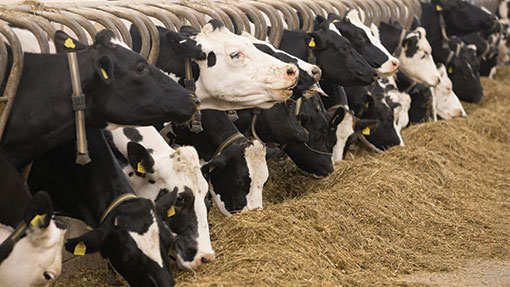‘Feed cows little and often to cut ration sorting’

Rations and feed were some of the central topics at the large herd seminar in Tortworth, Gloucester, last week. Rhian Price reports.
Feeding dairy cows smaller rations at regular intervals throughout the day could help prevent sorting, research has shown.
A study of 22 Canadian herds found, on average, cows sorted between 3-10%. But herds fed twice a day compared with those fed once a day sorted rations less.
More frequent feeding also resulted in a 1.4kg/day response in dry matter intake and, as a result, milk yields increased by 2kg/day.
See also: Foot-trimming practice must change, farmers told
Presenting the findings at the large herds seminar Trevor DeVries from Guelph University, Ontario, Canada, said: “Once that feed is put in front of them we think we have it right, [but] I have never seen a cow fed a mixed ration that doesn’t sort.”
Generally, cows sort for high fermentable feedstuff and leave fibre, Dr DeVries explained.
“Feed is delivered in smaller batches so there’s less opportunity to sort,” he added.
“A cow really likes consistency in terms of behaviour and rations, and from a feeding perspective there’s nothing better for a cow’s rumen than a consistent environment.”
Trevor DeVries, Guelph University
Dr DeVries said it was one thing to have the perfect ration on paper, but farmers needed to make sure it was being delivered to cows at the feed passage for rations to perform to expectations.
The study also found feed being delivered to the feed trough varied massively from day to day.
See also: Lower protein levels to increase milk production
For example, the percentage of long particles in the ration varied from 8-31% (16% on average).
Every 5% increase in long particles resulted in a 1.2kg/day drop in milk yield, explained Dr DeVries.
“A cow really likes consistency in terms of behaviour and rations, and from a feeding perspective there’s nothing better for a cow’s rumen than a consistent environment,” said Dr DeVries.
“The more consistent you keep that, you keep the microbial population of the rumen consistent and prevent swings in intake.
“Ration consistency is key. If you have more than one feeder or you have five or six different people who feed on a regular basis, what kind of tools have you got in place to make sure that feed is being feed consistently?
“Track loads to make sure what is being delivered and look at the difference between feeders.
“Ensure the feed that’s getting delivered matches formulations,” added Dr DeVries.
He advised selecting eight to ten samples along the feed barrier, putting it into a 5gal bucket before sampling.
